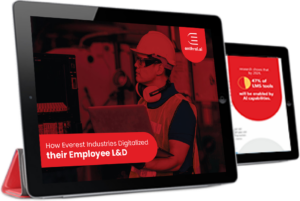Top 12 Must-have Features in LMS for Employee Training

Your Learning management System (LMS) is the cornerstone of all your learning and development initiatives. It efficiently stores, delivers, and facilitates various types of e-learning, covering everything from onboarding to compliance training and beyond.
Considering there are so many options on the menu, selecting an LMS that is most suitable for your organization can be overwhelming.
In this blog, we bring to you 12 must-have features in LMS for employee training. To make it easier for you, we have categorized the features by use case, so you get a better understanding at just a glance. That said, when it comes to LMS for employee training, every feature serves every use case and the categorization is just a matter of convenience for the blog.
Talent Development and Retention
1. Social Learning
At a time when the synergy of ‘social’ is all around us, it’s important that workplace learning isn’t in silos. Social Learning is an important feature of an LMS for employee training to create a collaborative learning environment that enhances training outcomes.
This feature enables your workforce to connect and interact with their peers and colleagues to cultivate essential power skills. It establishes learning spaces for teams within the same organization to communicate, collaborate, and share best practices, powered by subject-matter experts. Social Learning feature allows users to ask questions and share user-generated content, leading to learner engagement and knowledge-sharing.
2. Gamification
Gamification in LMS for employee training draws inspiration from the world of gaming, incorporating elements like points, badges, leaderboards, contests, and rewards. Infusing the essence of games into corporate learning transforms the learning process into an enjoyable experience.
There are also daily login rewards, interactive challenges and engaging missions that fuel learner motivation like never before. Gamification elements in an LMS enhance learner engagement, knowledge retention and competency, fostering healthy competition.
3. Blended Learning
Blended Learning in an LMS integrates traditional and online learning methods, offering a flexible and personalized training experience. A robust LMS with Blended Learning capabilities enables organizations to combine in-person sessions with digital resources, catering to diverse learning preferences and learner locations. This approach also allows your learners the flexibility to choose the type of learning that they feel the most comfortable with.
4. Integrations & Security
When it comes to online learning, the significance of video conferencing has become more necessary than ever in the recent past, especially for remote training needs. Integrations with video conferencing tools like Zoom, MS Teams, Google Meet, GoTo etc is a crucial feature in an LMS for employee training.
Additionally, seamless integrations with other content platforms and HRMS tools are also necessary to establish a holistic learning environment. The pre-built integrations offer learners a smooth and well-integrated learning experience with seamless training delivery.
5. ILT & VILT
An LMS’ Instructor-Led Training (ILT) feature helps to effortlessly coordinate and manage in-person training sessions. The LMS acts as a centralized platform, streamlining the entire workflow of in-person classroom training and improving the training experience for both facilitators and learners.
Likewise, the Virtual Instructor-Led Training (VILT) feature helps increase the reach of the training, especially when learners cannot make it to the place of the in-person training session. Instructors can effortlessly upload reading and learning materials, ensuring learners are well-prepared for their virtual sessions.
6. Content Authoring
The in-built Content Authoring tool of an LMS for employee training eliminates the tedious and time-consuming content development process. It brings rapid and captivating course creation to deliver engaging learning experiences.
This tool helps to effortlessly create compelling content that can be in the form of customized courses to meet learners’ needs, incorporating text, images, videos, audio, quizzes, and assessments for impactful learning.
7. Security & Privacy
An LMS for employee training must establish a secure and reliable learning environment for all learners with enterprise-grade security. A strong Security and Privacy feature provides identity verification, controlled cloud access, and data breach prevention, ensuring a safe learning experience for each learner.
Sensitive information is protected with comprehensive visibility into user activities, regardless of their location.
8. Reporting & Analytics
An LMS equipped with integrated Reporting and Analytics can monitor learners’ progress organization-wide, generating individual or group progress reports linked to learner activity. L&D professionals are increasingly recognizing the significance of using learning analytics to understand learner behaviours, thereby enhancing training quality and delivery methods.

How Everest Industries Digitalized their Employee L&D
-
Effective onboarding & training solution
- Dynamic system for competency mapping
- Deeper integration between HRMS & learning platforms
Employee Engagement
Employee engagement is a crucial factor to consider when deploying training programs. And what better way to engage employees than by offering them short and crisp relevant learning resources that they can access on-the-go.
Here are some important features of the LMS that encourage employee engagement.
9. Mobile Learning
For busy professionals, a key need is learning resources that they can access anytime, anywhere. Mobile Learning capability in an LMS is a must so that employees can easily access online content, including training courses, seamlessly on their smartphones and other mobile devices as per their convenience.
An LMS for employee training that lacks mobile-friendliness ends up limiting its reach to potential learners.
10. Multi Language Support
This is another feature that is paramount in an LMS for employee training as it ensures inclusivity and accessibility for a diverse workforce.
An LMS with support for multiple languages helps cater to diverse learners, overcoming the challenge of language barriers. It can be deployed in multiple languages, streamlining tasks and easing platform adoption for better learning outcomes.
11. AI-driven Personalized Learning
The integration of AI in an LMS facilitates the creation of tailored and individualized learning journeys for different learners. AI ensures increased employee engagement and motivation by delivering relevant content suited to individual needs. Learners benefit from access to curated courses and resources designed specifically for them.
Adaptive Learning in the LMS dynamically adjusts content based on individual progress and mastery levels.
Compliance Training
Regardless of industry, it is imperative to train employees on evolving industry standards, changing nature of compliance, and the latest regulatory changes so that the business remains risk-free.
Here’s how an LMS for employee training can improve compliance:
12. Certifications & Assessments
Oftentimes, training on certain topics and skills is not just about passing a particular test. It also necessitates having a documented proof, particularly when it aligns with an industry’s regulatory compliance obligations. This is where Certifications and Assessment features of an LMS proves invaluable where creating them becomes a quick and straightforward process.
LMSs supporting certification enable tracking of employees who have completed required courses, those yet to do so, and indicate when recertification is due. Likewise, assessment tools are crucial to track learner progress and making sure they complete the training satisfactorily.
Parting Thoughts
From training courses to webinars and onboarding, an LMS for employee training serves various purposes in most organizations. Selecting a feature-rich LMS enables streamlining of all L&D activities from a central location. Remember, the best LMSs are those that are adaptable to your organizational growth!
Discover how Enthral can seamlessly integrate into your organization, empowering its L&D initiatives – schedule a demo today!











